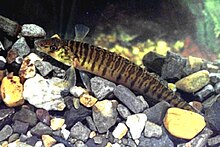Percina caprodes
| Common logperch | |
|---|---|
 |
|
| Scientific classification | |
| Kingdom: | Animalia |
| Phylum: | Chordata |
| Class: | Actinopterygii |
| Order: | Perciformes |
| Family: | Percidae |
| Genus: | Percina |
| Species: | P. caprodes |
| Binomial name | |
|
Percina caprodes (Rafinesque, 1818) |
|
The common logperch (Percina caprodes), sometimes simply known as the logperch, is a fish species in the family Percidae. Like other logperches, it has the typical vertical barring along the flank and a subterminal mouth.
This is the most widespread logperch, commonly found in large parts of the eastern United States and Canada. Like other logperches, they inhabit clear, gravelly streams and lakes, reaching a maximum size of about 18 centimeters (7.1 in) and a maximum age of about 3 years. They play a key role in the reproduction of the snuffbox mussel (Epioblasma triquetra).
The common logperch is a darter species naturally occurring as far north as the St. Lawrence River in Canada, as far west as the Great Lakes, and south throughout the Mississippi River down to the Rio Grande. The common logperch is also found as far west as California, where it was introduced in 1953. Logperch are benthic, nonguarding egglayers, whose embryos drift to lentic areas after hatching. The population distribution of the common logperch may be under increased predatory pressure from stocked saugeyes. Dams may also exert stress on the fish, by obstructing migratory pathways and inhibiting gene flow.Percina caprodes have also been found to be extremely susceptible to nitrite poisoning. While the common logperch is not currently listed as a threatened or endangered species, humans should be aware of our negative impact on the species, and the ways in which we can minimize this impact; most notably, by limiting the construction of dams, by increasing oxygen levels in the tailwaters of existing dams, by limiting the number of predatory gamefish stocked (such as saugeye), by decreasing the amount of silt and debris deposited in streams, and by monitoring nitrite levels in common logperch habitats. Also, a monitoring plan should be created, in which a routine census is taken of the fish in each area of its distribution, and in which invasive species that outcompete the common logperch, such as Neogobius melanostomus, are removed.
...
Wikipedia

